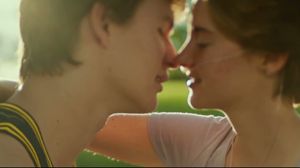You're obviously a sharp guy. If you hadn't done your job right, this film would have been a complete blur. Playing with depth of field is a classic production trick used to manipulate audiences and it's definitely a personal favorite (as you can see in my films). Done right, the technique lures the viewer's eyes and helps set the mood. For a film created within the dying-too-young-of-cancer genre, we'd expect that mood to be a sad one, yes, but also life-affirming. Except that would just be playing into a bad cliche, right? Heck, Shailene Woodley's character, Hazel, addresses that exact issue in the opening scene. She promises that this tear-jerker would not be sugar-coated. But then you come along with your beautiful soft-focus and bokeh effects, and betray the promising set-up of seeing something that feels real.
In terms of visuals, The Fault in Our Stars _clearly _doesn't take any risks. The camera techniques all fit squarely within the classic melodrama genre. The story is told mostly though use of close-ups, superfluous dolly shots and near undetectable zooms to build intensity and intimacy. Blurry edges help indicate when we are experiencing a past event and the rolling of focus (well done, by the way) when Hazel emerges from a coma creates an effective character's perspective. These are conventions because they work, after all, but they're also the very definition of sugar-coating a story.
Optics aside, you certainly had a lovely lead to focus on. Despite being terminally ill, Hazel is very easy on the eyes; a natural beauty seemingly without the aid of a hair and makeup team. Her effortless look helped capture a truth to her character's experience and allowed for a believable wisdom that matched her soulful eyes. Ansel Elgort, playing Hazel's (boy)friend Gus, is equally well cast. He's charming, warm, and seemingly full of life. When tragedy strikes, the pain and sorrow Hazel and Gus express on screen actually felt genuine. Their performances of two terminally-ill love-struck teens was killing me!
My new perspective as a mom meant I really had a hard time handling that part. And I wasn't the only one, based on all the sobbing I heard in the theater. For the first time, I found myself identifying with the paternal characters, specifically Hazel's mother (played lovingly by Laura Dern). So yes, I could have easily become swept up in the tragedy. But I found myself at an emotional distance. In part, maybe because this was my first film review for Dear Cast and Crew, so I was relieved to be wearing my "film critic's hat". But your tricks also kept pulling me out of the story, which is the exact opposite of what they're supposed to do.
The Fault in Our Stars purports to be "telling the truth" about love, yet keeps resorting to the same gimmicks that make romantic films feel so manipulative. You did what you were asked, Luuk, but you did it a little too well.







